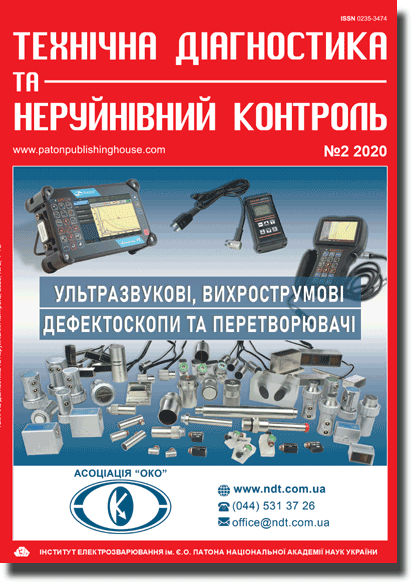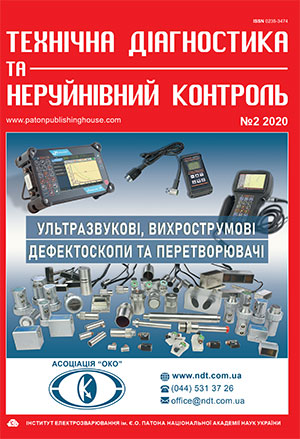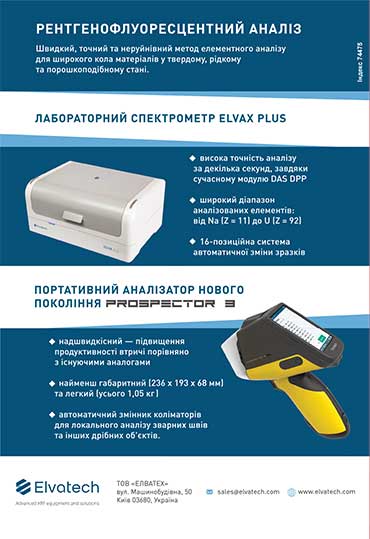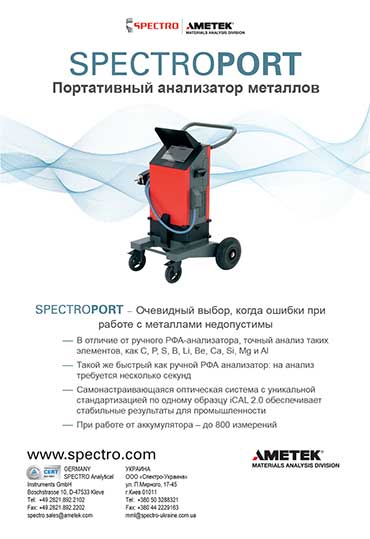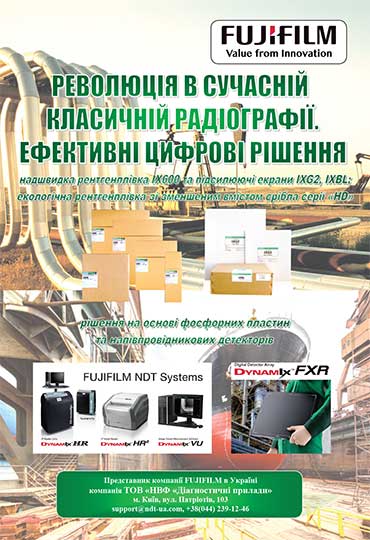| 2020 №02 (06) |
DOI of Article 10.37434/tdnk2020.02.07 |
2020 №02 (08) |
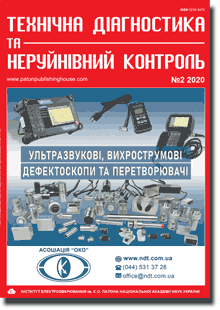
"Tekhnichna Diahnostyka ta Neruinivnyi Kontrol" (Technical Diagnostics and Non-Destructive Testing) #2, 2020, pp. 43-48
Simplified monitoring of metal structures without cleaning their surfaces
V.O. Troitskiy, V.A. Litvinenko
E.O. Paton Electric Welding Institute of NASU, 11 Kazymyr Malevych, Kyiv, 03150. E-mail: office@paton.kiev.ua
The formation of cracks, corrosion damage and aging of the metal are the main problem of long-life metal structures. Most often, these structures have unfavorable conditions for high-quality cleaning of their surface, which is required by the rules of nondestructive testing. To assess the condition of such numerous objects, there is the method of Alternative Current Field Measurement (ACFM). The ACFM method combines the physical foundations of eddy current and magnetic methods of non-destructive testing. ACFM devices are designed mainly for the detection of extended defects in the form of cracks without scraping the surface of the object, as well as for underwater control. There are many objects that are subject to control, have a poor surface of the object of control (OC) (rough surface, high roughness or poorly prepared OC surface, etc. of welded structures and other metal products). Let us conditionally call this idea Crack Testing (CT). CT idea is implemented not only by the ACFM method, but also by the traditional methods of electro-magnetic acoustic (EMA), magnetic flux leakage (MFL), and eddy – current testing (ET). 13 Ref., 1 Tabl., 6 Fig.
Keywords: metal structures, nondestructive testing, ACFM, eddy current, magnetic powder, EMA, cracks, flaw detection, crack testing, defects
Received: 17.07.2019
References
1. Ge Jiuhao, Li Wei, Chen Guoming Yin Xiaokang et al. (2017) Analysis of signals for inclined crack detection through alternating current field measurement with a U-shaped probe. Non-Destructive Testing and Condition Monitoring, 59(3), 121-128. https://doi.org/10.1784/insi.2017.59.3.1212. Li Wei an, Chen Guoming, Yin Xiaokang et al. (2013) Analysis of the lift-off effect of a U-shaped ACFM system. NDT&E Intern., 53, 31-35. https://doi.org/10.1016/j.ndteint.2012.10.001
3. Eddyfi Technologies. https://eddyfi.com/en (Accessed 22.06.2020).
4. TSC Subsea. https://www.tscsubsea.com/ (Accessed 22.06.2020).
5. Troitskyi, V.A. (2018) Defectoscopy of XXI century. Kiev, PWI [in Russian].
6. Sharanova, D.A. (2016) Contactless methods of detection of pitting defects in metal product walls. Territoriya Neftegaza, 10, 34-40 [in Russian].
7. Kirikov, A.V., Zabrodin, A.N., Komlik, A.V. (1999) Methods and means of ultrasonic testing of rolled stock with application of electromagneto-acoustic transducers. V Mire Nerazrushayushchego Kontrolya, 3, 18-20 [in Russian].
8. Potapov, A.I., Syasko, V.A., Pudovkin, O.P. (2015) Optimization of parameters of primary measuring transducers implementing the MFL technology. Defektoskopiya, 8, 64 [in Russian].
9. Slesarev, D.A., Abakumov, A.A. (2013) Data processing and presentation in MFL method of nondestructive testing. Ibid., 9, 3 [in Russian]. https://doi.org/10.1134/S106183091309009X
10. Potapov, A.I., Syasko, V.A., Solomenchuk, P.V. et al. (2015) Electromagnetic and magnetic methods of nondestructive testing of materials and products. Vol. 2. St.-Petersburg, Nestor-Istoriya [in Russian].
11. Gulyaev, A.P. (1986) Metals science. Ripol Classic [in Russian].
12. Troitskyi, V.A., Radko, V.P., Demidko, V.G., Bobrov, V.T. (1986) Nondestructive testing of welded structure quality. Kiev, Tekhnika [in Russian].
13. EMWORKS, Alternating Current Field Measurement. https://www.emworks.com/application/alternating-current- field-measurement (Accessed 22.06.2020).
Advertising in this issue:
The cost of subscription/purchase order journals or individual articles
| Journal/Currency | Annual Set | 1 issue printed |
1 issue |
one article |
| TPWJ/USD | 384 $ | 32 $ | 26 $ | 13 $ |
| TPWJ/EUR | 348 € | 29 € | 24 € | 12 € |
| TPWJ/UAH | 7200 UAH | 600 UAH | 600 UAH | 280 UAH |
| AS/UAH | 1800 UAH | 300 UAH | 300 UAH | 150 UAH |
| AS/USD | 192 $ | 32 $ | 26 $ | 13 $ |
| AS/EUR | 180 € | 30 € | 25 € | 12 € |
| SEM/UAH | 1200 UAH | 300 UAH | 300 UAH | 150 UAH |
| SEM/USD | 128 $ | 32 $ | 26 $ | 13 $ |
| SEM/EUR | 120 € | 30 € | 25 € | 12 € |
| TDNK/UAH | 1200 UAH | 300 UAH | 300 UAH | 150 UAH |
| TDNK/USD | 128 $ | 32 $ | 26 $ | 13 $ |
| TDNK/EUR | 120 € | 30 € | 25 € | 15 € |
AS = «Automatic Welding» - 6 issues per year;
TPWJ = «PATON WELDING JOURNAL» - 12 issues per year;
SEM = «Electrometallurgy Today» - 4 issues per year;
TDNK = «Technical Diagnostics and Non-Destructive Testing» - 4 issues per year.





